Manchester City vs. Arsenal: How Guardiola’s adaptations to the Gunners brought them the win.
Introduction and line-ups
The title decider, the game of the season, the teacher against his student or however you want to label this clash. It was time for Manchester City against Arsenal.
The Gunners are having an outstanding season and deservingly sit on top of the table. However, the last few games saw a little drop in performance, which enabled the Citizens to get nearer to the number one spot (also because of their incredible form recently). The stakes were high, and everything was set for a fascinating game.
Let’s get right into the line-ups. Manchester City used a 4-3-3 on paper with the backline consisting of Akanji, Dias, Stones and Walker. Gündogan, Rodri and De Bruyne formed the midfield three. Grealish and Silva were positioned on the wings with Haaland up top. This shape however turned into a 4-2-4/4-2-1-3 with the ball and a 4-4-2 out of possession with De Bruyne besides Haaland.
Arsenal set up in a 4-3-3 on paper as well. Zinchenko, Gabriel, Holding and White formed the back four. The Gunners used their regular midfield three with Xhaka and Odegaard alongside Partey. Up front was Jesus beside Martinelli and Saka. Their 4-3-3 structure could regularly transition into a 3-2-5 in possession with Zinchenko inverting and a 4-1-4-1/4-4-2 without the ball, as Odegaard frequently joined Jesus.
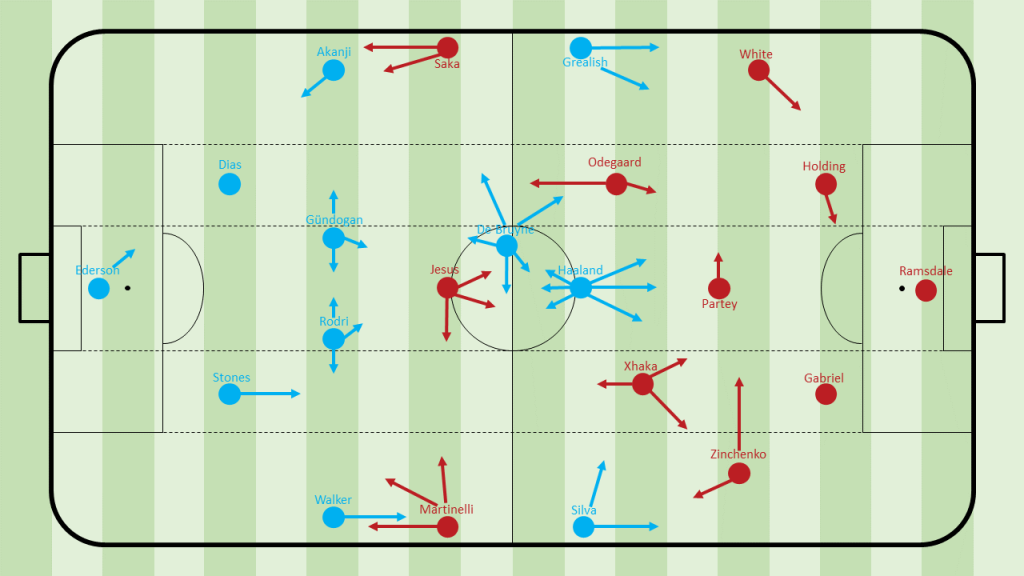
Dominating without the ball – the first 15 minutes
Although Arsenal had a lot more of the ball in the first 15 minutes, it was actually Manchester City, who dominated the game out of possession. Pep Guardiola worked out a pressing approach, which enabled his side to deal with the rotations of the Gunners and use the ball-playing weaknesses of Holding towards their advantage.
When Arsenal built up from the back using a 4-3-3, Haaland usually sat deeper on Partey, while De Bruyne initiated the press on Gabriel (and could press through on Ramsdale if he received the ball). However, it could also at times be the other way around. City’s double pivot went man to man against Arsenal’s 8s (Odegaard and Xhaka). However, the ball-far 6 from the Citizens would move across in a ball-oriented manner to keep the compactness and control the space in between the lines. As soon as White or Zinchenko received the ball, they were under aggressive pressure from Man City’s wingers. Key were the distances as well as the timing of the wingers’ movements, which enabled them to engage the fullbacks quickly and hinder any further progression.
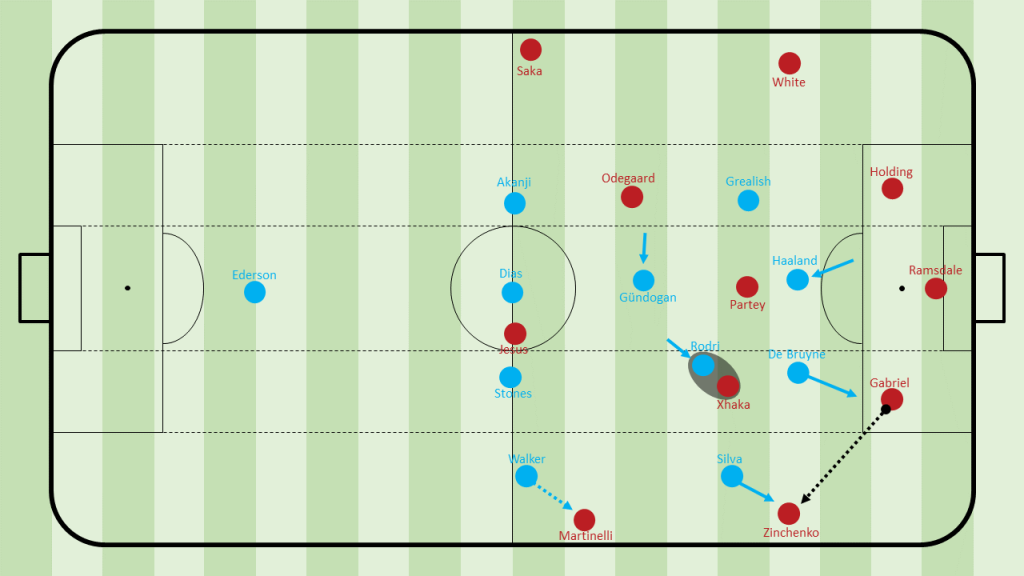
Nevertheless, the Gunners used their familiar 3-2-5/3-2-2-3, with Zinchenko inverting alongside Partey and White staying deeper to form a back three, probably more often than the 4-3-3 (especially in settled possession).
However, as already mentioned, Pep Guardiola had a good plan to stop this Arsenal structure as well. Haaland kept his task by staying near Partey and De Bruyne still pressed Gabriel (or Ramsdale) by ideally using his cover-shadow on Zinchenko. Rather than following the Ukrainian left back inside, Silva handed Zinchenko over to Rodri. The Portuguese therefore marked Xhaka, who could frequently drop wide. Communication was key in this instance. Gündogan stayed near Odegaard but was ready to move up on Partey if Haaland couldn’t keep his cover-shadow. This then forced Dias into pressing the Norwegian midfielder.
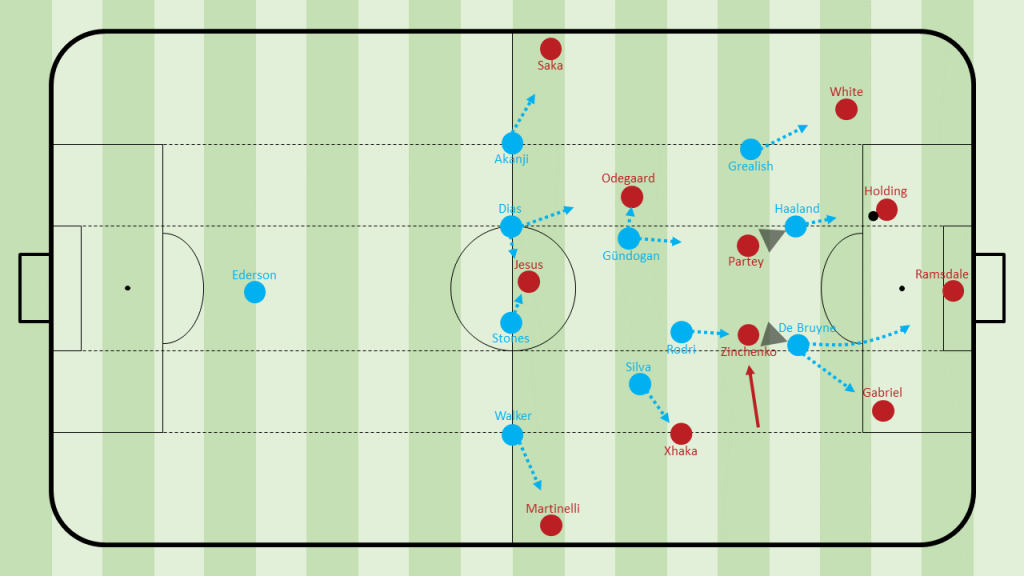
Even though this pressing approach regularly led to Man City’s backline being 1v1 and having a lot of space to defend, they dealt quite well with it. However, this was also because Arsenal struggled to threaten the depth frequently with runners in behind.
Moreover, Manchester City’s setup out of possession meant that Holding was usually the free man and given quite some time on the ball. Only Haaland would press him partially (although without too much intensity). The English defender already struggled in the past few games with replacing Saliba’s on-the-ball qualities. Guardiola cleverly exploited this weakness by closing down the middle (using tight man-orientations) and giving Holding the licence to build the play.
The Citizens won the ball regularly high up the pitch in the wide areas or forced inaccurate long balls under intense pressure. Arsenal tried to bypass this press with Jesus dropping deep from time to time, but he was normally tightly followed by a centre back and the midfielders could press backwards to double/triple up as well.
Despite Arsenal having more of the ball in the first 15 minutes (although with Man City restricting the Gunners to no chances), Kevin De Bruyne was able to score a wonderful goal after a Manchester City build-up sequence:
Dias played the ball back to Ederson, which triggered Arsenal to press aggressively. The Brazilian passed on to Stones, who was then under pressure by two opponents. The Englishman played a superb ball forward into Haaland, who shielded the ball off well against Holding and found De Bruyne’s movement in behind (after getting away from Partey on the blind-side). The Belgian dribbled a few metres cut inside onto his right foot and ended up scoring just outside the box.
Man City’s adapted build-up mechanisms and how De Bruyne sliced through Arsenal
The Citizens’ first goal represented a lot of concepts, which the hosts tried to do with the ball to exploit Arsenal (something we’ll discuss in this section). However, it wasn’t until the around 15-minute mark that Manchester City completely dominated the game in possession.
Rather than setting up in their recent 3-2-5 in possession with Stones as an inverted fullback, Pep Guardiola opted for a 4-2-4/4-2-1-3. Both fullbacks stayed deep (only Walker could advance from time to time), and the double pivot was positioned near the two centre backs. Higher up, De Bruyne was given a lot of freedom and could roam around in between the lines or temporarily be a second striker alongside Haaland. The wingers held the width on either side to stretch Arsenal’s backline horizontally.
To stop ManCity, Arteta’s side went with a 4-1-4-1/4-4-2 out of possession. Jesus was tasked with putting the centre backs under pressure. Xhaka, the left 8, marked Rodri tightly. Odegaard, the right 8, initially marked Gündogan but regularly pressed through on Dias, leading to the 4-4-2. This movement from Odegaard forced Partey to move up on Gündogan, leaving his initial opponent (De Bruyne) free in between the lines. Nevertheless, a centre back (who depended on the Belgian’s positioning) could engage De Bruyne. This led to 1v1s in the backline and the Arsenal defenders having to cover a lot of space, which – in contrast to City – they struggled to do.
It was truly astonishing how De Bruyne constantly occupied the right spaces dynamically in between the lines to be accessible and make use of the spaces he was given. His horizontal movements but also his runs in behind as well as the dismarking movements were a joy to watch and frequently threatened the Gunners.
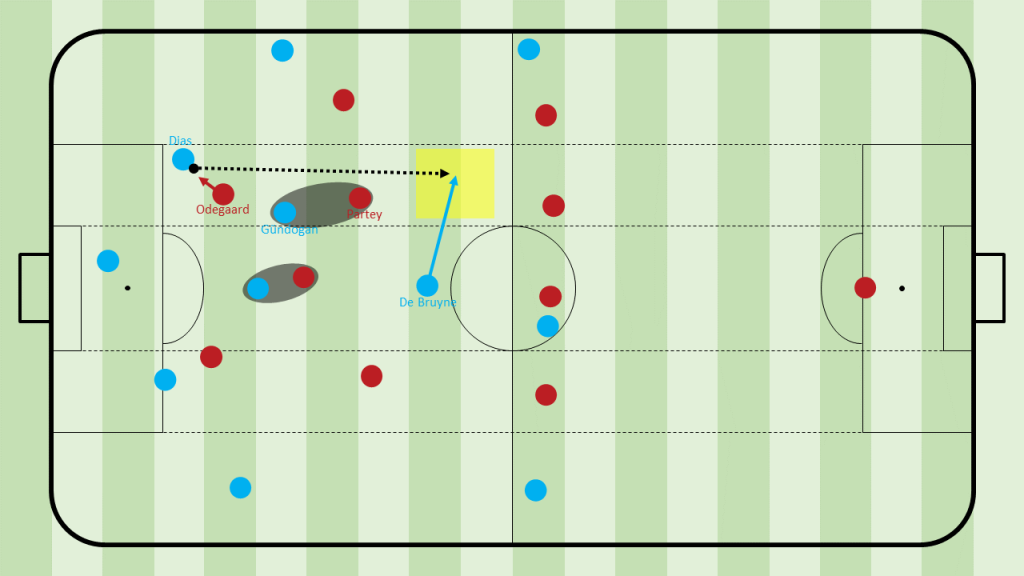
Crucial in the build-up for Manchester City was also the double pivot consisting of Gündogan and Rodri. They did a great job at supporting Ederson as a bounce option – despite being under pressure – to find a free centre back and regularly made clever little movements to be accessible. Additionally, the different staggering enabled them to combine and outplay a temporary central overload.
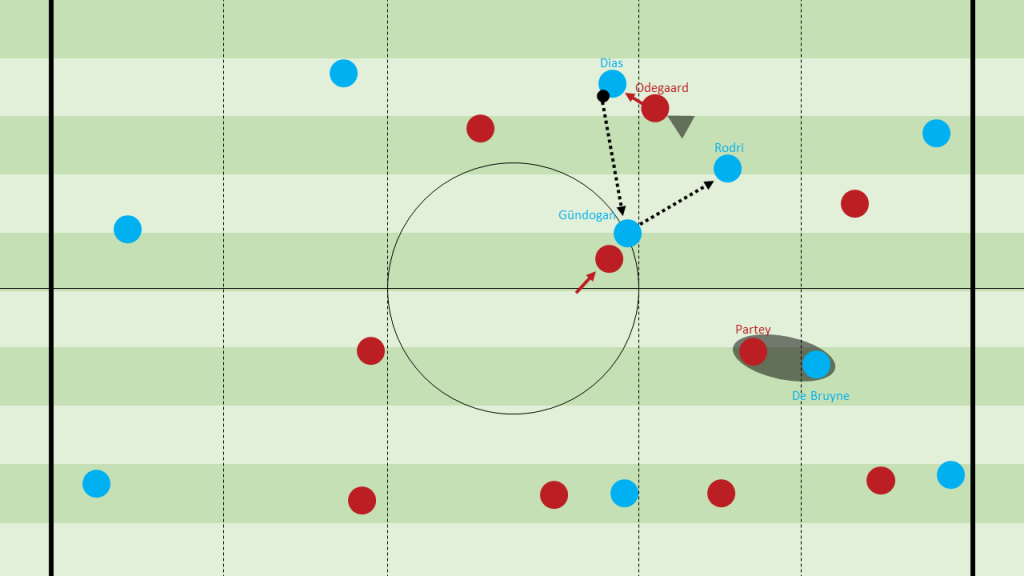
Haaland also deserves a lot of credit for Man City’s win. The Norwegian improved in particular in the last weeks and regularly looks to include himself in City’s possession sequences by dropping deep and laying the ball off to a teammate. Additionally, his aerial qualities and physical strength were regularly used against Arsenal to bypass the pressure with long balls (as seen at the first goal).
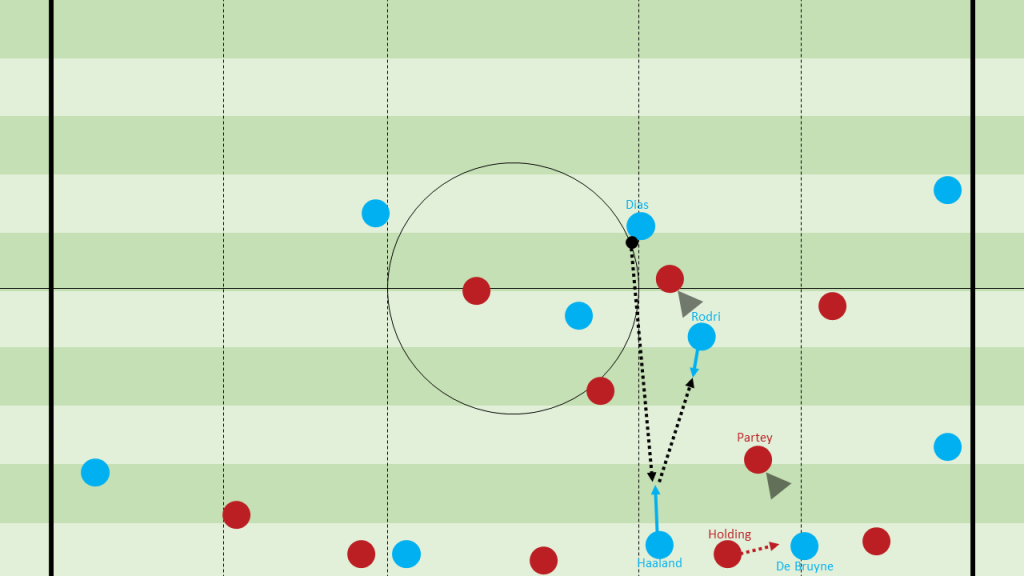
Here’s a brilliant interview from Kevin De Bruyne, who basically sums up Manchester City’s mechanisms in possession, his free role, and their adaptations to Arsenal:
2nd half developments
The 2nd half instantly started like the first one. Man City built up with a long ball from Ederson into Haaland, who laid the ball off to Silva. The Portuguese then found De Bruyne in behind, exploiting a gap in Arsenal’s backline, but eventually missed the ball through a volley. After this sequence, Arsenal tried to build-up at the back, but Man City’s high press with De Bruyne pressing through on Ramsdale forced the keeper to play a long ball, with Stones ultimately winning the aerial duel.
The Gunners adapted their pressing approach slightly and were more aggressive in the second half. Saka pressed Dias from out to in, while White moved up on Akanji. Odegaard and Xhaka marked the Citizens’ double pivot alongside Partey being tasked to track De Bruyne.
Nevertheless, this different setup didn’t come to fruition, as Manchester City quickly scored the third goal, which was the eventual knock-out. Odegaard played a misplaced pass into De Bruyne, who quickly passed on to Haaland and ultimately got it back from the Norwegian to score his second goal of the night. A brilliant turnover with Haaland linking up and once again a top movement from De Bruyne to exploit the space in the left half-space.
Arsenal kept on trying to create anything meaningful with the ball in the second half but failed to sufficiently break down Man City’s 4-4-2 block. Holding’s goal in the 86th minute after the Gunners won the ball back again from their own corner and combined through to the Englishman inside the box was too late for a spirit of optimism. Instead, it was Haaland in stoppage time, who let his hair run free and put the ball in the net.
Conclusion
It was an outstanding display from Man City. They were especially impressive in the first half both with and without the ball. Guardiola’s little tweaks to Arsenal proved to be more than successful. With seven games left to play for Manchester City, they are now the favourites to win the Premier League title once again. They currently sit two points behind Arsenal with two games in hand and with their current form, it’ll be difficult to stop them.
If you have any questions, please do not hesitate to contact us.



